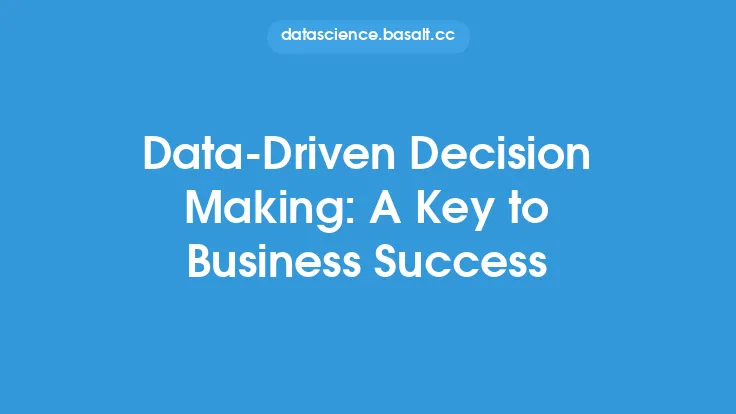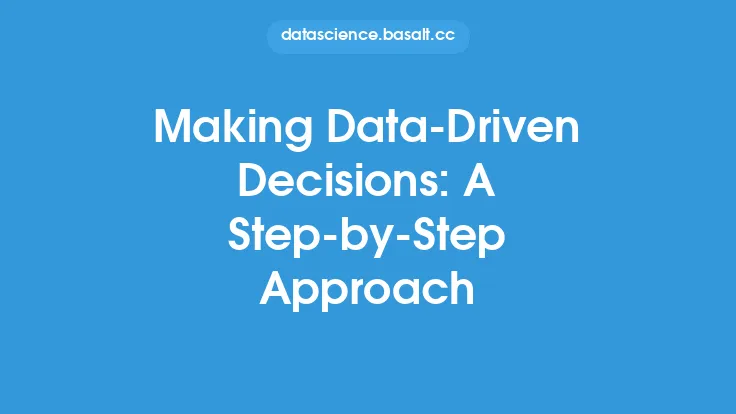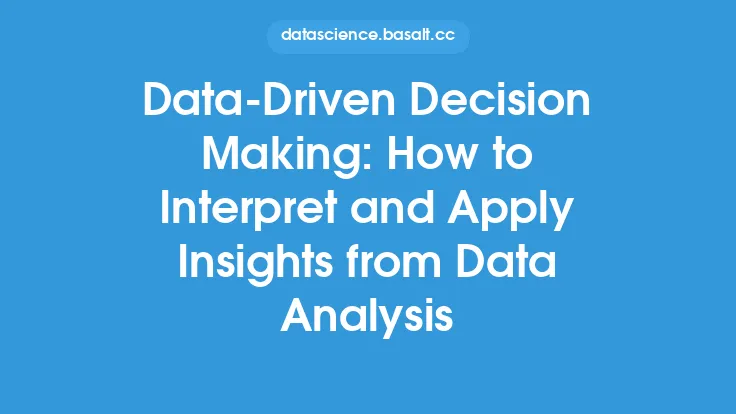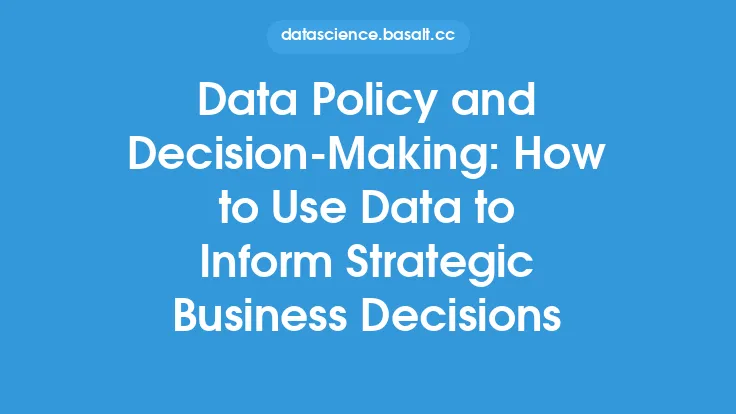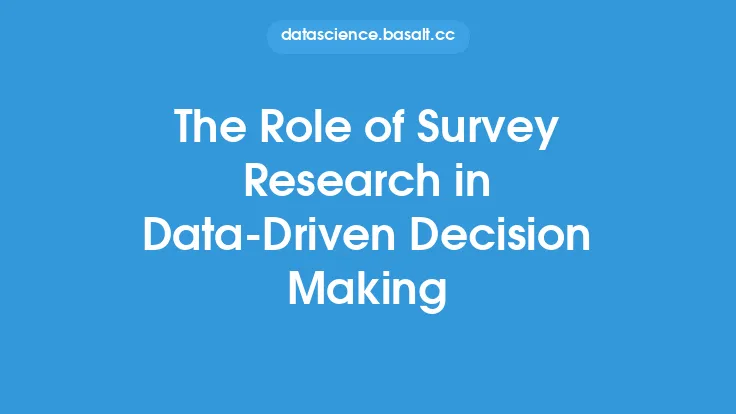In today's fast-paced and competitive business landscape, organizations are constantly seeking ways to gain a competitive edge and make informed decisions that drive growth and success. One approach that has gained significant attention in recent years is the use of data-driven decision making. This approach involves using data and analytics to inform strategic decisions, rather than relying on intuition or anecdotal evidence. By leveraging data and analytics, organizations can uncover hidden insights, identify trends and patterns, and make more informed decisions that drive business outcomes.
Introduction to Data-Driven Decision Making
Data-driven decision making is an approach that involves using data and analytics to inform strategic decisions. This approach is based on the idea that data can provide a more accurate and objective view of the business, allowing organizations to make more informed decisions. Data-driven decision making involves a range of activities, including data collection, data analysis, and data interpretation. By using data and analytics, organizations can identify trends and patterns, uncover hidden insights, and make more informed decisions that drive business outcomes.
The Benefits of Data-Driven Decision Making
There are several benefits to using a data-driven approach to strategic decision making. One of the primary benefits is that it allows organizations to make more informed decisions. By using data and analytics, organizations can uncover hidden insights and identify trends and patterns that may not be apparent through other means. This can help organizations to avoid making decisions based on intuition or anecdotal evidence, which can be unreliable and lead to poor outcomes. Additionally, data-driven decision making can help organizations to identify opportunities and risks, and to develop strategies that mitigate these risks and capitalize on these opportunities.
The Role of Data Analytics in Decision Making
Data analytics plays a critical role in data-driven decision making. Data analytics involves the use of statistical and computational methods to analyze and interpret data. This can include a range of activities, such as data mining, predictive analytics, and data visualization. By using data analytics, organizations can uncover hidden insights and identify trends and patterns in the data. This can help organizations to develop a deeper understanding of their business and to make more informed decisions. Additionally, data analytics can help organizations to identify opportunities and risks, and to develop strategies that mitigate these risks and capitalize on these opportunities.
The Process of Data-Driven Decision Making
The process of data-driven decision making involves a range of activities, including data collection, data analysis, and data interpretation. The first step in this process is data collection, which involves gathering data from a range of sources, such as customer feedback, sales data, and market research. Once the data has been collected, it must be analyzed using statistical and computational methods. This can include a range of activities, such as data mining, predictive analytics, and data visualization. Finally, the results of the analysis must be interpreted and used to inform strategic decisions.
Common Data-Driven Decision Making Techniques
There are several common techniques used in data-driven decision making. One of the most popular techniques is predictive analytics, which involves using statistical models to forecast future outcomes. This can be used to predict customer behavior, forecast sales, and identify potential risks and opportunities. Another common technique is data mining, which involves using computational methods to identify patterns and relationships in the data. This can be used to identify customer segments, develop targeted marketing campaigns, and optimize business processes. Additionally, data visualization is a common technique used in data-driven decision making, which involves using graphical representations to communicate complex data insights.
The Importance of Data Quality in Data-Driven Decision Making
Data quality is critical in data-driven decision making. Poor data quality can lead to inaccurate insights and poor decision making. Therefore, it is essential to ensure that the data used in decision making is accurate, complete, and consistent. This can involve a range of activities, such as data cleaning, data validation, and data normalization. Additionally, it is essential to ensure that the data is properly documented and maintained, to ensure that it can be easily accessed and used in decision making.
Overcoming Common Challenges in Data-Driven Decision Making
There are several common challenges that organizations face when implementing data-driven decision making. One of the most significant challenges is the lack of data quality, which can lead to inaccurate insights and poor decision making. Another common challenge is the lack of skills and expertise, which can make it difficult to analyze and interpret the data. Additionally, there may be cultural and organizational barriers to adopting a data-driven approach, such as a lack of trust in data or a preference for traditional decision-making approaches. To overcome these challenges, organizations must invest in data quality initiatives, develop the skills and expertise of their employees, and foster a culture that values data-driven decision making.
Best Practices for Implementing Data-Driven Decision Making
There are several best practices that organizations can follow to implement data-driven decision making. One of the most important best practices is to start small, by identifying a specific business problem or opportunity and using data and analytics to inform the decision. Another best practice is to develop a clear understanding of the business goals and objectives, and to use data and analytics to inform decisions that drive these goals. Additionally, it is essential to invest in data quality initiatives, to ensure that the data used in decision making is accurate, complete, and consistent. Finally, organizations must foster a culture that values data-driven decision making, by providing training and development opportunities for employees and encouraging a culture of experimentation and innovation.
The Future of Data-Driven Decision Making
The future of data-driven decision making is exciting and rapidly evolving. One of the most significant trends is the increasing use of artificial intelligence and machine learning, which can be used to analyze and interpret large datasets and provide insights that inform strategic decisions. Another trend is the increasing use of cloud-based data platforms, which can provide organizations with the scalability and flexibility they need to analyze and interpret large datasets. Additionally, there is a growing recognition of the importance of data ethics and governance, which involves ensuring that data is used in a responsible and transparent way. As data-driven decision making continues to evolve, it is likely that we will see new technologies and techniques emerge, such as augmented analytics and automated decision making. These technologies have the potential to revolutionize the way organizations make decisions, by providing them with the insights and information they need to drive business outcomes.
